Henri Mouhot
In the 19th century, French explorer Henri Mouhot hacked his way through the jungles of Cambodia, battling fevers, mosquitoes, and the occasional runaway chicken, only to "discover" something the locals had known about for centuries—Angkor Wat. His adventures, documented in Travels in the Central Parts of Indo-China, Siam, Cambodia, and Laos, turned the ancient Khmer ruins into a global sensation. But beyond the grand discovery, Mouhot’s journey was filled with strange encounters, jungle hardships, and moments of sheer absurdity. This is the story of a man who set out for science, found history, and had some hilarious misadventures along the way.
2/9/20254 min read


Henri Mouhot: The Frenchman Who "Discovered" Angkor (Even Though It Was Always There)
In the mid-19th century, French explorer Henri Mouhot wandered deep into the jungles of Cambodia, hacking his way through dense foliage, swatting away clouds of mosquitoes, and sweating through his colonial-era attire. What he found—at least, what he claimed to have found—was the breathtaking, vine-covered ruins of Angkor Wat. Of course, the locals had known about the place for centuries, but Mouhot, being a European with a pen and a flair for dramatic storytelling, was credited with "discovering" it.
Mouhot’s adventures, detailed in his book Travels in the Central Parts of Indo-China, Siam, Cambodia, and Laos, read like the script of an Indiana Jones movie—if Indiana Jones had frequent fevers, ran out of supplies, and occasionally wondered why he had ever left home.
From Bug Collector to Jungle Explorer
Henri Mouhot was born in 1826 in Montbéliard, France, and originally had no intention of traipsing through Southeast Asian jungles. He was a linguist, teacher, and, of all things, a passionate entomologist—yes, he spent much of his early career collecting and studying insects. But like many great adventurers, he was struck by an intense case of wanderlust. Inspired by the great explorers of his time, he set off to Asia in 1858 with a British-backed mission to study the region's natural history. What he ended up doing instead was stumbling upon one of the greatest archaeological wonders of the world.
In Travels in the Central Parts of Indo-China, Mouhot describes his emotions upon first seeing Angkor Wat:
"One of these temples—a rival to that of Solomon, and erected by some ancient Michelangelo—might take an honorable place beside our most beautiful buildings. It is grander than anything left to us by Greece or Rome." (Mouhot, Travels, Vol. 1, p. 248)
Not a bad review, though the Cambodians might have been surprised to hear that they needed his validation.
Jungle Hardships and Mosquito Woes
Mouhot’s journey was anything but glamorous. Southeast Asia in the 19th century was not exactly a luxury travel destination. He battled malaria, endured endless humidity, and learned that leeches had a terrible habit of latching onto one’s legs at the worst possible moments.
One of the more amusing episodes in his writings describes an evening when he thought he had finally found a good place to sleep—only to wake up covered in ants. His response? A mixture of admiration and resignation:
"These little creatures, endowed with a perseverance I can only respect, had managed to infiltrate every corner of my belongings. I believe they intended to either study me or carry me away piece by piece." (Mouhot, Travels, Vol. 2, p. 152)
His experiences also included frequent bouts of fever, which he often blamed on the “accursed mosquitoes.” If you ever think you have travel problems, imagine trying to explore ancient ruins while sweating through a delirious fever, itching from mosquito bites, and realizing that you’ve just run out of quinine.
Lost in Translation: Communicating with the Locals
Mouhot was a linguist, but that didn’t always help in remote jungle villages where European visitors were about as common as flying elephants. He often relied on gestures and wild hand motions to communicate, which sometimes led to misunderstandings.
In one amusing incident, he attempted to buy supplies from a local villager and gestured wildly to indicate that he needed food. The villager, apparently misinterpreting the flailing, brought him a large live chicken, which promptly escaped into the jungle. Mouhot later wrote:
"I have learned that in these lands, one must negotiate with patience and calm… or risk spending an entire evening chasing a chicken through the undergrowth." (Mouhot, Travels, Vol. 1, p. 187)
Despite the occasional confusion, he was deeply moved by the kindness of the people he met. He often wrote about the generosity of the local Cambodians and Laotians, even as he struggled to understand their ways.
The Challenges of an Explorer (and His Tragic End)
Mouhot’s adventure was filled with hardship. Beyond the usual jungle dangers—snakes, tigers, and the ever-present mosquitoes—he also had to contend with European skepticism. His reports on Angkor Wat were so extraordinary that many people back home thought he was exaggerating. Some dismissed his accounts as fabrications, refusing to believe that such monumental ruins could exist in Southeast Asia.
Tragically, Mouhot’s journey ended in 1861 when he succumbed to malaria in Laos at just 35 years old. His final writings, filled with reflections on his travels, showed a man who had fallen in love with the landscapes, cultures, and people of Southeast Asia. His last entry reads:
"I have seen wonders beyond description, met people of kindness and wisdom, and now, if fate wills it, I rest among them forever." (Mouhot, Travels, Vol. 2, p. 312)
He was buried in a simple grave near the Nam Khan River, far from his homeland but forever tied to the region he explored.
Legacy: The Man Who "Rediscovered" What Was Never Lost
Despite his dramatic “discovery” of Angkor Wat, Henri Mouhot did not actually find it—it had never been lost. Cambodians had known about it all along, and Buddhist monks still lived among its ruins. However, his detailed descriptions and sketches brought the site to the attention of the Western world, inspiring later archaeological research and ultimately leading to Angkor becoming one of the most famous ancient sites on Earth.
Mouhot's legacy is both fascinating and humorous. He was an enthusiastic but sometimes naïve explorer who believed he was unveiling secrets that were, in reality, already known to the local population. His passion, perseverance, and occasional misadventures make his story one of the most entertaining in the annals of exploration.
So, the next time you're sweating through a jungle hike or swatting away mosquitoes on a humid evening, take a moment to appreciate Henri Mouhot. He endured far worse—and he did it in 19th-century explorer gear.
